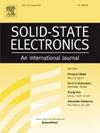Interlayer exchange coupling for enhanced performance in spin-transfer torque MRAM devices
IF 1.4
4区 物理与天体物理
Q3 ENGINEERING, ELECTRICAL & ELECTRONIC
引用次数: 0
Abstract
We present a micromagnetic modeling study that explores the impact of interface exchange coupling in multilayered spintronic devices, such as the spin-transfer torque magnetoresistive random access memory, which is at the forefront of nonvolatile storage. By examining the exchange interactions facilitated by non-magnetic or insulating layers between ferromagnetic ones, we explore the critical role of interlayer exchange coupling in the magnetic stability and domain dynamics essential for the efficiency of spin-transfer torque mechanisms. This understanding is crucial for enhancing device performance, particularly in terms of data reliability and access speeds, amid the ongoing miniaturization trend in nanotechnology. The magnetic tunnel junction within spin-transfer torque magnetoresistive random access memory, featuring a CoFeB-based layered structure, enables significant data density improvements through reduced cell sizes and enhanced magnetic properties. However, miniaturization also raises concerns about the reliability and stability of these devices, particularly due to phenomena like back-hopping. Our research addresses these concerns by highlighting the role of IEC in achieving magnetic alignment and optimizing overall device performance, thereby meeting the rigorous requirements of modern memory applications and paving the way for the next generation of memory technologies.
层间交换耦合提高自旋传递扭矩MRAM器件的性能
我们提出了一项微磁建模研究,探讨了界面交换耦合在多层自旋电子器件中的影响,例如自旋传递扭矩磁阻随机存取存储器,这是非易失性存储的前沿。通过研究非磁性或绝缘层之间的交换相互作用,我们探讨了层间交换耦合在自旋传递转矩机构效率所必需的磁稳定性和域动力学中的关键作用。在纳米技术不断小型化的趋势下,这种理解对于提高设备性能至关重要,特别是在数据可靠性和访问速度方面。自旋转移转矩磁阻随机存取存储器中的磁隧道结具有基于cofeb的分层结构,通过减小单元尺寸和增强磁性能,可以显着提高数据密度。然而,小型化也引起了人们对这些设备的可靠性和稳定性的担忧,特别是由于反向跳变等现象。我们的研究通过强调IEC在实现磁对准和优化整体器件性能方面的作用来解决这些问题,从而满足现代存储器应用的严格要求,并为下一代存储器技术铺平道路。
本文章由计算机程序翻译,如有差异,请以英文原文为准。
求助全文
约1分钟内获得全文
求助全文
来源期刊

Solid-state Electronics
物理-工程:电子与电气
CiteScore
3.00
自引率
5.90%
发文量
212
审稿时长
3 months
期刊介绍:
It is the aim of this journal to bring together in one publication outstanding papers reporting new and original work in the following areas: (1) applications of solid-state physics and technology to electronics and optoelectronics, including theory and device design; (2) optical, electrical, morphological characterization techniques and parameter extraction of devices; (3) fabrication of semiconductor devices, and also device-related materials growth, measurement and evaluation; (4) the physics and modeling of submicron and nanoscale microelectronic and optoelectronic devices, including processing, measurement, and performance evaluation; (5) applications of numerical methods to the modeling and simulation of solid-state devices and processes; and (6) nanoscale electronic and optoelectronic devices, photovoltaics, sensors, and MEMS based on semiconductor and alternative electronic materials; (7) synthesis and electrooptical properties of materials for novel devices.
 求助内容:
求助内容: 应助结果提醒方式:
应助结果提醒方式:


